
This site uses cookies, by continuing to use this site you accept the terms of our privacy policy
Feed 2.0 Loading...
Pentland Survey Work Now Underway
6th August 2013
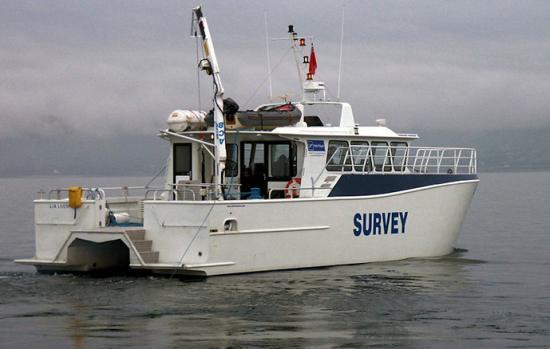
Detailed sea-survey work for a tidal stream electricity 'array' in the Pentland Firth is in full swing just now with specialist vessel Lia.
The officers and crew of a specialist vessel, owned by a venerable British family business with a history dating back over 200 years, have been busy this week (starting 04.08.13) in the Pentland Firth conducting detailed surveys in connection with a planned sub-sea 'tidal stream electricity' power station.
The 15.3 metre long aluminium-built catamaran Lia is being utilised by the consortium that was awarded one of four seabed stakes in the Firth during the 'first round' of Crown Estate seabed leases, issued in 2010.
Lia is operating for the lease-holder, a 50:50 joint venture between Perth-based SSE (Scottish & Southern Energy) Renewables Ltd and 'horizontal hydro' turbine developers Open Hydro Tidal Technologies Ltd , of Dublin, Ireland, famous in the nascent industry for its unique 'polo-mint' design. The latter is now controlled by French naval shipbuilder DCNS, following a majority-stake sale finalised in March this year.
Cantick Head Tidal Development Ltd, as the concessionaire is known, aims to have around 30 MW of turbine capacity installed for 2015/2016, with the site's full 200 MW capacity generating by 2020/21.
Although the 11 square kilometre site is known as 'Cantick Head', after the cape with the prominent lighthouse at the eastern tip of South Walls that marks the main sea-route from the Firth into Scapa Flow, the array's planned location is now more likely to be off Hoy's Brims Ness.
This is because earlier surveys, including works done by Mey-based Energy Hunt Ltd, showed that a similar-size sea area overlapping Westwards from the originally-awarded site, offers superior power-generation prospects.
The Lia's intensive 2013 summer works, in waters between 60 and 80 metres deep, are a precursor to an early 'consenting' application to Marine Scotland. The location lies between 7 and 8 miles North-North-West from Gills Bay.
The vessel is operated by Osiris Projects, of Merseyside. This is now part of Bibby Group Marine Survey Services Ltd, which is in turn a component of the Bibby Line Group, of Liverpool. The diversified business that has been in the founding Bibby family hands since 1809, now has ship-owning and management, financial services and retail (the 'Costcutter' chain) in its portfolio, while it opened an Aberdeen-based offshore energy-support unit nine years ago.
Bibby Line became famous in the 19th and early 20th centuries for its role in providing essential passenger and freight-goods shipping sea-links between Britain and its far-flung former Empire, especially with the Indian sub-continent.
The Cantick Head site will become almost certainly the second one to be developed in the Firth, partly overlapping with the deployment of MeyGen Ltd's initial 6-turbine 'demonstration array' in the much shallower Inner Sound planned from mid-2014 onwards.
Scottish Power Renewables Ltd, which has the Crown Estate Ness of Duncansby seabed lease off John O'Groats, is first developing its 10-turbine 'demonstration array' in the more sheltered Sound of Islay seabed site, also starting next year.
The other 'first round' lease in the Firth was awarded to Marine Current Turbines Ltd, off Broughness, the southernmost tip of South Ronaldsay, where a white-painted former Coastguard Station was prominent.
MCT, which has operated the successful tidal turbine in Northern Ireland's Strangford Lough for the past five years, is now part of the German-controlled Siemens group. It is understood that it is looking for a utility partner company for its Broughness's development.
Like the area's best known twin-hulled vessel, the Gills Harbour ferry Pentalina, the Lia was designed in Australia. Although she can cruise at a respectable 16 knots, she has specialist on-board 'trolling valves' which allow the shallow-draught vessel to be kept under full control at speeds as low as 1 knot, if required.
Lia has a through-deck 'moonpool' with an on-board hydraulic crane allowing her to deploy side-scan and ROV (remote operated vehicle) equipment. for detailed seabed studies.
She is under the same ownership/management as Chartwell, which kicked off Wick Harbour's involvement as a shore-base for Moray Firth offshore wind. This was when Chartwell was based at the Caithness port for an extended spell in 2011/2012. This was reportedly thanks to locally-born on-board marine surveyor Mr Chris Sinclair, whose father John is the MD of Caithness Creels Ltd, now the only significant fishing-gear manufacturer in the Caithness town.
John Thouless is SSE's Marine Developments Manager, responsible for Cantick Head and others of its off-shore sites. SSE is Britain's largest renewable-electricity generator, having taken over the 1950s-built North of Scotland Hydro Electric Board power-stations, many of which it is upgrading in an multi-million pound on-going programme.
In view of the proximity of the Cantick Head seabed site, Mr Thouless has asked to be kept fully abreast of developments suitable for tidal stream vessel usage at Gills Harbour and has reserved the right to make suitable suggestions, if necessary.
Open Hydro is continuing to test its latest 'open centre' prototype turbine at the European Marine Energy Centre's (EMEC) tidal site off Eday, Orkney this year.
Reporter Bill Mowat
Related Businesses
Related Articles
21/10/2022
Three Cats At Gills Harbour
Two catamaran work-boats berthed at Gills Harbour this week with the trans-Pentlnd ferry MV Alfred, also a catamaran, in the background. The larger workboat is MPC Athenia which was being used as a floating base or ROVs - remote underwater vessels, for detailed inspections on the three turbines operating at the MeyGen demonstration subsea site one and a half miles off Gills Harbour.
12/6/2022
GILLS HARBOUR Ltd ANNUAL GENERAL MEETING
GILLS HARBOUR Ltd - ANNUAL GENERAL MEETING at JOHN O'GROATS VILLAGE HALL, MONDAY JUNE 13th @ 7.30 PM. GILLS HARBOUR IS THE ONLY OFFICIALLY-RECOGNISED 'ECONOMIC DEVELOPMENT AREA' IN NE CAITHNESS.22/3/2021
Latest Boats At Gills Harbour For Work At Meygen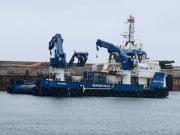
£10 million 'Isle of Jura' temporarily based at Gills Harbour in Far North of Scotland for her crew's debut tasks in the tidal-stream electricity field at the MeyGen sub-sea site, one mile off the little Caithness's port entrance channel. One of the UK's most modern marine renewables service vessels made her debut calls at community-owned Gills Harbour, near John O'Groats, over the 2021 Spring Equinoctial weekend.
23/2/2021
Busy Gills Harbour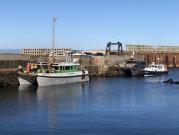
Its been a busy few days at local community-owned Gills Harbour ..... sometimes in suberb sunny weather as here ...
26/11/2020
Energy Developments Continue at Gills Harbour and the Pentland Firth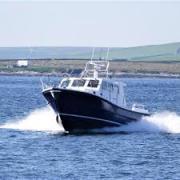
The company behind the world-leading tidal-stream prototype power plant in the Pentland Firth's Inner Sound is set to start manufacturing a new-style turbine that is hopes will reduce the project's generating costs. Simec Atlantis Energy (SAE) and a privately-owned specialist engineering firm from Spain's Bay of Biscay coastline have jointly been conducting 'research and development' (R& D) on the project for almost a year and are now ready to give it the go-ahead.
8/10/2020
New Generation of office-bearers set to step up at Gills Harbour Ltd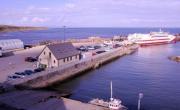
A new generation of younger local folk look set to take over the reins of running Gills Harbour Ltd, the local company that owns and operates the busy little port on the shores of the Pentland Firth's Inner Sound that holds its AGM this Saturday (10.10.20) morning at 10:00 am. The influx of younger blood comes after two key directors of the group that had run 'Canisbay's Peoples Port' both announced their retirement from office, whilst another Gills Harbour Ltd (GHL) office-bearer has declined to seek re-election.
19/8/2020
MV Alfred And MV Pentalina Together At Gills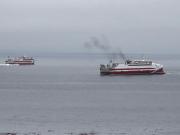
An 'old friend' returns to Gills Bay after an absence of manymonths. The 2,400 tonne 70 m.
16/8/2020
Normand Cutter, The Norwegian-owned Offshore Construction Vessel at Gills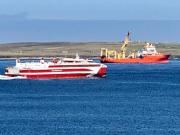
Here is the Normand Cutter, the Norwegian-owned offshore construction vessel that has been the base for works on Simec Atlantis Energy's (SAE's) MeyGen site in the Pentland Firth's Inner Sound, off Gills Bay during the current neap-tide sequence, that has lasted most of the week commencing 11.08.20. Picture by retired C of S Kirk Minister the Rev Lyall Rennie, who lives at Lower Warse, Canisbay, on the shores of Gills Bay..
9/10/2019
New Ferry For Pentland Ferries Arrives Safely
Scotland's most modern + environmentally-friendly, fuel-efficient ROPAX ferry ship rge MV Alfred, arrived AM today (Wed 09.10.19 at St Margarets Hope. The boat went round to Kirkwall immediately at the end of 9,000+ miles voyage from the Strategic Marine yard near Ho Chi Minh city (ex.
20/3/2019



